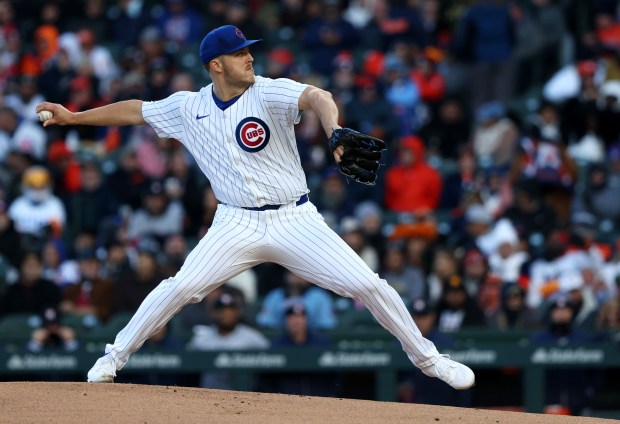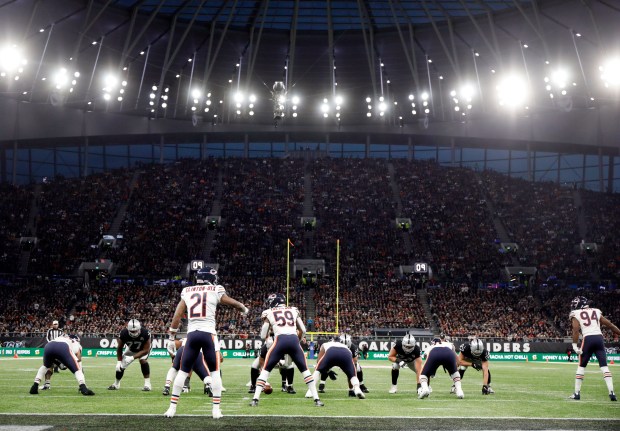As injuries have mounted, the Cubs find a way to keep rolling.
Their 3-1 victory Thursday, featuring Pete Crow-Armstrong’s first big-league hit — a two-run, go-ahead homer in the sixth inning — completed a three-game sweep of the Houston Astros and ended the homestand on a high note as the Cubs head to Boston and New York for a seven-game trip.
For the second consecutive year, the White Sox have had a March and April to forget. After their 6-3 loss to the Minnesota Twins on Thursday, they are a combined 11-43 during those months over the last two seasons. At 3-22, they are tied for the worst 25-game start of the wild-card era (since 1995).
Every Friday during the regular season, Tribune baseball writers will provide an update on what happened — and what’s ahead — ahead for the Cubs and White Sox. Want more? Sign up for our new newsletters.
Right-hander Jameson Taillon picks up where he left off last season
Taillon firmly believed last year’s poor start was an aberration and not the type of performance he would be known for in a Cubs uniform.
Taillon posted a 6.93 ERA through 14 starts last season before turning things around with a 3.38 ERA over his final 16 appearances (15 starts). The right-hander has picked up where he left off despite missing the beginning of the season because of a back injury he suffered in spring training.
In his two starts since coming off the injured list, Taillon allowed only one earned run in each outing. The Cubs desperately need quality innings from their starters during this stretch of 16 games without an off day, and Taillon delivered Wednesday night against the Astros. He tossed 5⅔ innings in the Cubs’ 4-3 win.
“Before that back injury, I just really liked where we were at and I feel like we were able to use that downtime to stay on the straight and narrow, stay on the right path so I’m not really surprised and not in an arrogant way,” Taillon said. “I thought we were working on a lot of the right things.”
This version of Taillon, if he can keep it up, would provide a big lift for an otherwise inexperienced rotation that includes left-hander Jordan Wicks, right-hander Javier Assad and, at times, right-hander Ben Brown.
“I do take a little bit of responsibility to try to be the guy to go out there and go deep and provide some length,” Taillon said. “Ideally, I go deeper than I did (Wednesday) and my last one going forward. But yeah, that’s just a point of pride in general for me.”
Starter Erick Fedde has been a bright spot for the Sox
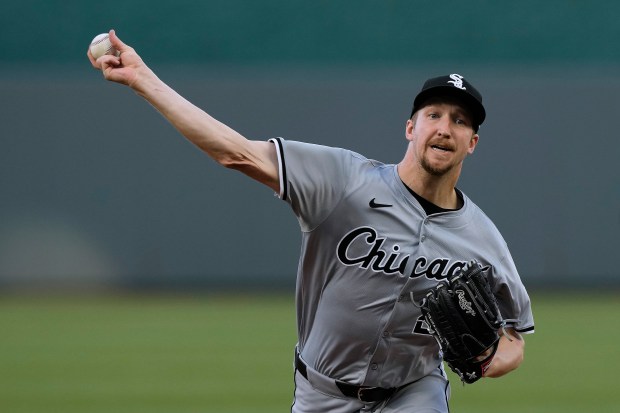
Erick Fedde surrendered three consecutive two-out hits in the first inning Tuesday against the Minnesota Twins, including an RBI single to Max Kepler.
“I was still pretty happy with my stuff,” Fedde told the Tribune on Wednesday. “ I didn’t get the cutter up enough when (Trevor Larnach) got the double, and I thought I jammed (Byron) Buxton, he snuck it down the line and Kepler, I thought I made a good pitch on a changeup and I think he was just looking for it.
“And then it was just not getting rattled by that and continuing with what I thought was working.”
It all started clicking for Fedde, who retired the final 16 batters he faced.
“It’s great, especially when the game’s close,” Fedde said of the stretch. “I want to give us a chance to catch back up and eventually when we did, keep the lead. That’s about as good as you can be. I want to get the guys back in the dugout as quickly as possible. When things are grooving, it feels nice.”
Fedde allowed one run on three hits in six innings. He did not factor in the decision in the 6-5 loss at Target Field.
“I thought my changeup was amazing, it set everything up in general,” he said. “That’s what I would say was the reason for the success.”
Fedde had a career-high 11 strikeouts and didn’t surrender a walk in the 95-pitch outing.
“It’s a great sign, it means my pitches are working,” Fedde said of the strikeouts. “It’s been a lot of focus this year on sequencing and getting up and getting down, something I didn’t do in the past. Never been a great throwing up in the zone type of pitcher and I feel like I’ve added that to my game and it’s really keeping guys off-balanced.”
Fedde has been one of the bright spots for the Sox. He entered Thursday ranked 15th in the American League with a 2.73 ERA.
“It’s definitely a good sign, what we want,” Fedde said. “I feel like I’m starting to get deeper in games, be a little more effective and giving the guys a chance to win. As long as I can do that, things are good.”
Number of the week: .161
The Sox rank 29th in the majors with a .161 average with runners in scoring position through their first 24 games. The Sox are 24-for-149, collecting one or no hits in those situations in 18 of the 24 games.
Week ahead: Cubs
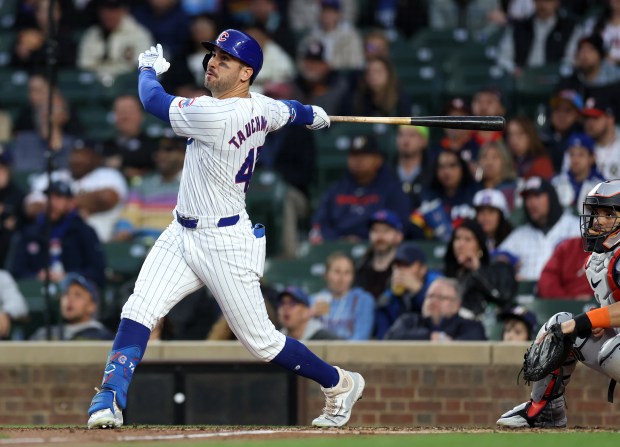
- Friday: at Red Sox, 6:10 p.m. Marquee
- Saturday: at Red Sox, 3:10 p.m. Marquee
- Sunday: at Red Sox, 6:10 p.m. ESPN
- Monday: at Mets, 6:10 p.m. Marquee
- Tuesday: at Mets, 6:10 p.m. Marquee
- Wednesday: at Mets, 6:10 p.m. Marquee
- Thursday: at Mets, 12:10 p.m. Marquee
Expect to see manager Craig Counsell lean on his left-handed hitters on this upcoming stretch.
Based on opposing rotations’ construction on their upcoming schedule, the Cubs know that they will face almost exclusively right-handed starters during this challenging 16-game stretch. This sets up outfielders Mike Tauchman and Pete Crow-Armstrong and first baseman Matt Mervis joining Michael Busch to be used often, knowing countering a lefty-heavy lineup will be difficult.
Tauchman’s approach had been lauded at the start of the season when he was still finding ways to get on base despite hits not falling. Those hits are finally starting to come, most notably in Tuesday night’s win when he delivered his second career multihomer game. The Cubs will need their role players thrust into more playing time because of injuries to step up.
“I try to make myself available for 162 (games) plus,” Tauchman said. “I show up to the park every day ready to go and whatever happens, happens. … Good teams have depth and good teams have guys step up and that’s what we intend to do.”
Week ahead: White Sox
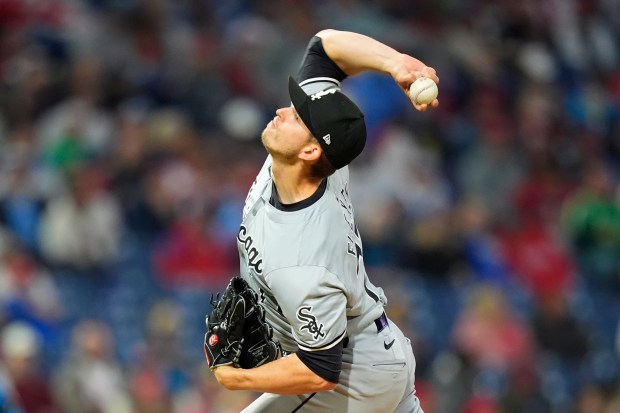
- Friday: vs. Rays, 6:40 p.m., Apple TV+
- Saturday: vs. Rays, 6:10 p.m., NBCSCH
- Sunday: vs. Rays, 1:10 p.m., NBCSCH
- Monday: vs. Twins, 6:40 p.m., NBCSCH/FS1
- Tuesday: vs. Twins, 6:40 p.m., NBCSCH
- Wednesday: vs. Twins, 1:10 p.m., NBCSCH
- Thursday: off
The Sox didn’t want to wear out their bullpen in the April 19 series opener against the Philadelphia Phillies at Citizens Bank Park after starter Garrett Crochet lasted three-plus innings.
Chris Flexen rose to the challenge, allowing one hit and striking out four in four scoreless innings in his first relief outing of the season.
“I was able to control some counts a little better, got ahead a little better,” Flexen told the Tribune. “Had a pretty good mix, I thought (catcher Martín Maldonado) and I mixed pretty well with some pitches and really able to execute that night.
“It’s always nice to have good results. Understanding the situation where we really needed some length, we were down 7-0 at the time, and to still be able to keep the game there was big.”
Flexen, who signed a one-year deal with the Sox in the offseason, is 0-3 with a 6.41 ERA in five appearances (three starts).
“Still the same job, still got to get outs, still got to compete and try to win a ballgame,” he said of the preparation needed out of the bullpen.
He’s scheduled to return to the rotation and start Friday’s series opener against the Tampa Bay Rays at Guaranteed Rate Field.
This week in Chicago baseball
April 26, 1941: Cubs became the first major-league team to have organ music at a ballgame
Ray Nelson was obliged to still his bellows at 2:30 p.m. because his repertoire includes many restricted ASCAP arias, which would have been picked up by the radio microphones at Wrigley Field hooked up a half-hour before game time.
The Tribune reported that a Cubs theme song entitled “When the Midnight Choo Choo Leaves for T-U-L-S-A” was in the works after Nelson’s debut and directed those who could think of a better title for a song to send their suggestions to general manager James T. Gallagher — as well as “any little number you’d like to have rippled off some afternoon, fitting the aria to the baseball score at the time, of course.”
April 29, 2015: White Sox play the Orioles in an empty stadium
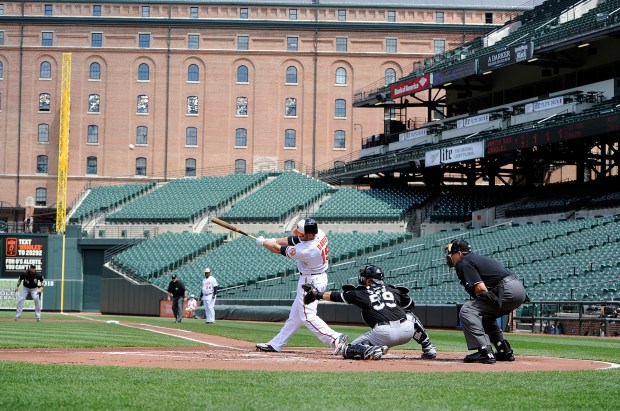
The White Sox and Orioles met on a pleasant, sunny day at Camden Yards for what is believed to be the first major-league game closed to the public, a result of security concerns after unrest in Baltimore surrounding the death of Freddie Gray, a 25-year-old man who suffered a spinal injury while in police custody.
The attendance will go in the record books as zero, but the ballpark wasn’t completely empty for the Orioles’ 8-2 victory. Scouts occupied three seats in front of the plate, photographers weaved their way through empty rows and 92 assigned seats in the press box were filled, approximately three times more than for the scheduled series opener.
The Sox called the atmosphere “weird” and “different.”
“It was just a surreal environment,” Sox manager Robin Ventura said. “I don’t think we really want to play another one like this. … I don’t think (the Orioles) do either.”
The national anthem was played. The players warmed up to music between innings and walked to the plate while the announcer spoke their names over the sound system. The video board displayed the lineups, the players’ pictures and stats.
They even played “Take Me Out to the Ball Game” for the seventh-inning stretch, though nobody was around to stand up and head to the vacant restrooms or unmanned concession stands.
Sox second baseman Micah Johnson said the glare of the unoccupied seats was distracting on defense. He could hear the TV announcers in the booths and the Orioles in their dugout. And he was self-conscious about his vocal reactions to mistakes as he called out “no” and “my bad.”
May 1, 1951: Minnie Miñoso becomes the White Sox’s first Black player
After spending 1950 in the Pacific Coast League, Miñoso returned to the majors with Cleveland before being dealt to the White Sox as part of a three-way deal on April 30.
He became the franchise’s first Black player, homering in his first at-bat with the Sox against Vic Raschi of the Yankees.
Miñoso hit .326 with 10 home runs, 76 RBIs and 112 runs in 146 games with Cleveland and the Sox, earned his first American League All-Star selection and placed fourth in AL MVP voting and second for AL Rookie of the Year. He ranked first in the AL in triples (14), stolen bases (31) and hit by pitches (16). He was second in average and runs and fourth in hits (173).
May 1, 1960: Comiskey Park’s exploding scoreboard debuts
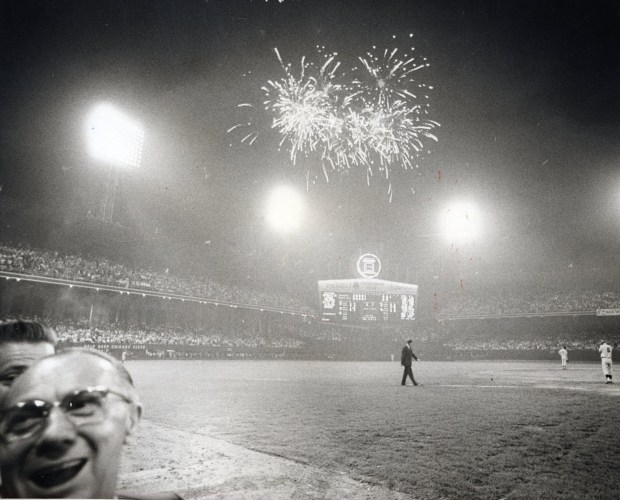
The idea for one of baseball’s greatest spectacles came while Bill Veeck was watching Jimmy Cagney in “The Time of Your Life.”
“This character in the film was always playing pinball machines,” Veeck told the Tribune in April 1960. “Toward the finish he finally hit the jackpot and there was the darndest racket and flashing of lights you ever heard or saw.”
So Veeck wondered: Why can’t a ballpark have such a symphony of sound and light? And why not Comiskey Park?
The $300,000, 130-foot-wide scoreboard featured lights, sirens, a “Soxogram” message board and multicolored pinwheels. The Tribune’s Jerome Holtzman called it a “screeching banshee.”
The board was fully christened when Sox outfielder Al Smith hit a two-run homer off Jim Bunning in the bottom of the first against the Tigers.
“Cheers of 29,586 spectators still were ringing in their ears and their eyes were half-blinded by the multicolored send-off given them by the electrical monster in center field,” the Tribune reported the next day.
What we’re reading this morning
- Chicago White Sox fall to 3-22 — tied for worst 25-game start of wild-card era — with 6-3 loss to Minnesota Twins
- Chicago Cubs reliever Luke Little is undeterred after having to replace glove with American flag patch: ‘I just want to represent my country’
- Chicago Cubs veteran Kyle Hendricks isn’t making excuses as he hits the IL. Up next: An honest self-evaluation.
- Chicago White Sox made history with their 8th shutout in 22 games. Here’s a closer look at each missed scoring opportunity.
Quotable
“That’s my hometown team. I grew up rooting for the Astros hard. I watched every single game on TV growing up, so it’s still cool to play against them. But yeah, I mean, they’ve been tough for me in the past. They’re going to be tough going forward. So, it feels good to get a win.” — Taillon on facing the Astros, whom he had never beaten previously in his career.


